How I Taught My Child 1000 Chinese Characters as a Non-Fluent Speaker
Between the ages of 2.5 to 5 years, my third-generation American daughter learned over 1000 Chinese characters while I learned to speak and read Chinese with her.
Chinese was the first language that my daughter learned to read. She reads simplified Chinese characters fluently and also recognizes an unknown number of traditional Chinese characters without the aid of Pinyin or Zhuyin.
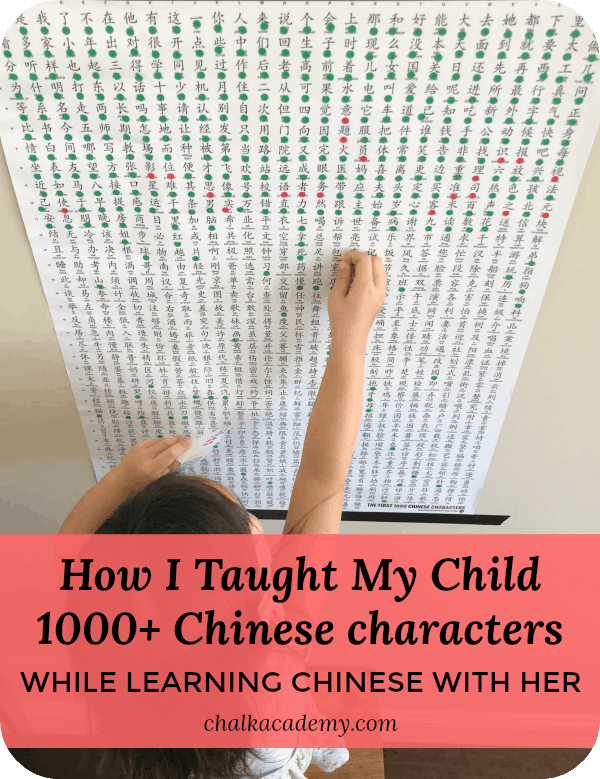
Chalk Academy is reader-supported. Some of the links are affiliate links. When you buy something through an affiliate link, we may earn a very small commission at no additional cost to you. More details here.
Teaching my child Chinese against all odds
This achievement is unusual because I taught my daughter Chinese largely on my own while lagging significantly behind in my own language skills (note: the Pinyin addiction is real).
- I rarely spoke Chinese during my own childhood, and effectively stopped when my parents passed away.
- English is our family language – our native language. My daughter spoke English and Korean during her first 22 months of life, then lost almost all Korean vocabulary between age 2-3 when we moved and didn’t have a Korean-speaking nanny.
- Currently, we live in a California county with ~3% Asians. Encounters with native Mandarin speakers are rare.
- When my daughter was age 2, I began to learn Chinese and included Mandarin in our conversations gradually. Between age 2-3, she was very resistant and preferred English.
Simply put, the odds have been stacked against us.
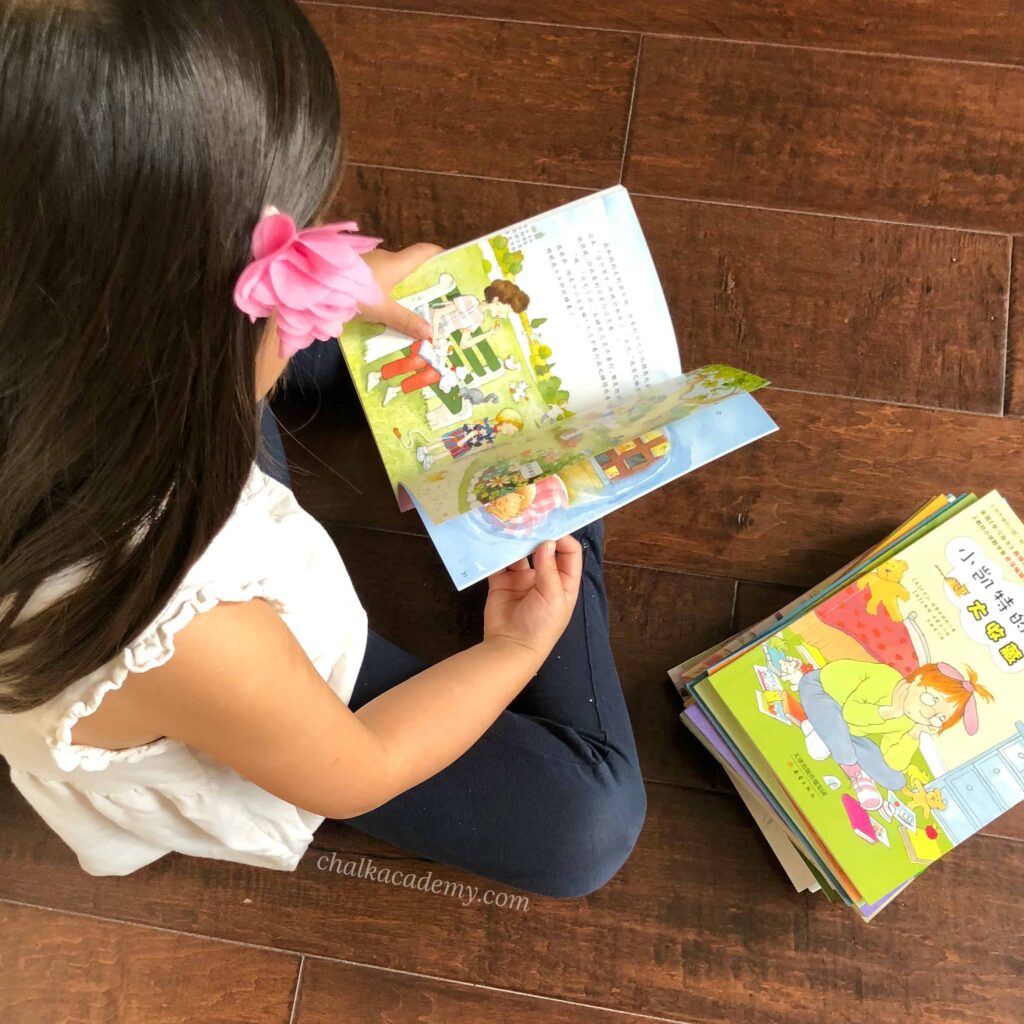
Despite these limitations, my daughter now loves to speak, sing, and read Chinese!
Words that I mispronounce are corrected swiftly by my daughter: “妈妈,你需要练习多一点!(Māmā, nǐ xūyào liànxí duō yī diǎn / Mama, you need to practice more)!
She teaches me lyrics of her favorite Chinese songs.
This past summer, she surpassed 1200 Chinese characters and enjoys reading picture books and chapter books.
However, reading comprehension is far more important than mastering X number of characters.
Usually, my daughter can understand what she reads on first pass, while I need to read through the same passage at least twice to figure out what I have read.
Therefore, many people have asked how someone with limited language skills as myself could raise a child to be effectively trilingual for her age.
I actually started to draft this part of our language story a year ago but was hesitant about sharing it.
I was worried that parents would miss my mission of healthy, child-led, playful learning and push kids to read before they are ready.
I strongly believe that childhood should be full of play, and academics should not be forced.
If you make a habit of featuring Chinese characters in daily life, I believe that you and your child can learn without realizing it.
We adults often limit ourselves because of preconceived notions and past challenges. In contrast, young children naturally love to learn if they think it is a normal part of life.
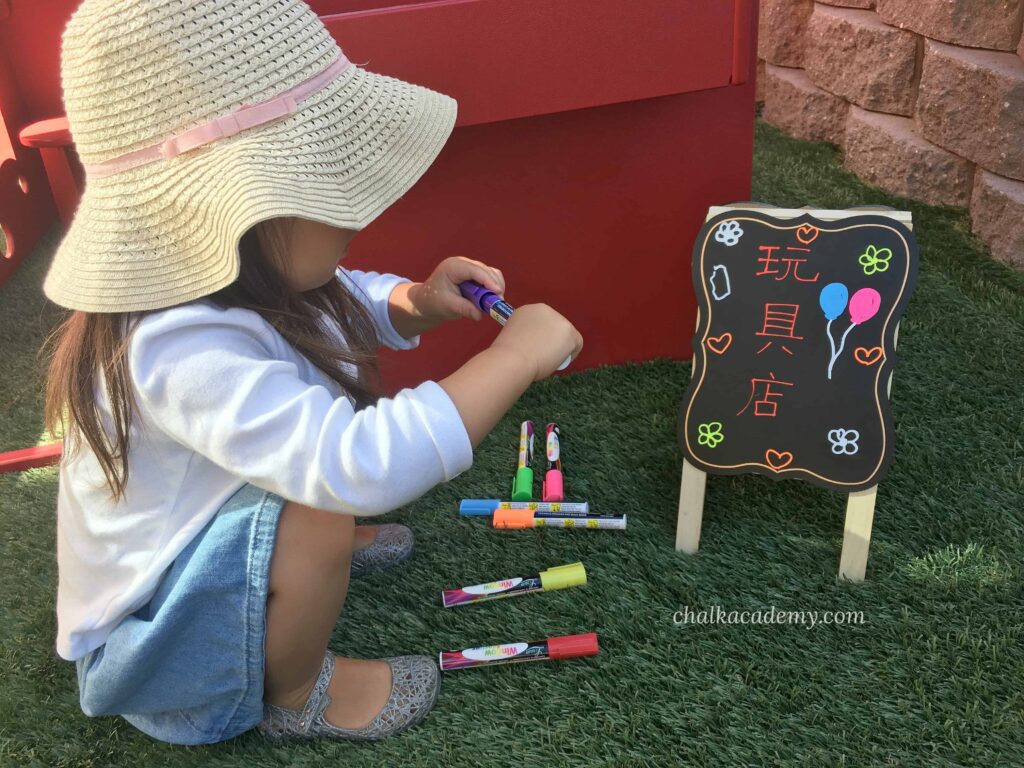
Learning to read Chinese with my daughter: A special bonding experience
Last year, I remember my daughter thoughtfully sharing with me that she has “pictures and movies in her head.”
妈妈!我要告诉你一件重要的事情! (Māmā! Wǒ yào gàosù nǐ yī jiàn zhòngyào de shìqíng! / Mama! I have to tell you something important!)
你知道我脑筋里有照片吗?(Nǐ zhīdào wǒ nǎojīn li yǒu zhàopiàn ma? / Did you know that my head has pictures in it?)
还有电影! (Hái yǒu diànyǐng! / And also movies!)
My daughter then asked if I had images in my head like her, and we discussed that those are 回忆 (huíyì / memories).
She told me that when she wants to think of something that makes her happy, she looks at the pictures in her mind.
She gave the example of how much fun she had seeing a Lion Dance performance at a local Chinese New Year festival a couple years ago. In order to re-experience it, she will “play the Lion Dance movie in her mind”.
The point of sharing this is not to talk about her memory skills but rather these points:
- She has eloquently articulated her desire to cherish happy moments.
- Kids are constantly learning and developing positive and negative associations with every experience, even if there was no explicit teaching intent.
Since my Chinese language attrition is partly due to bullying and other painful childhood experiences, I have been determined to make Chinese learning positive for both of us. We have no need to learn Chinese, because English is compulsory in our community.
Learning Chinese has been challenging, but I am grateful for this second chance with my children. We are making special memories, and love is the magic ingredient. My children know that Chinese learning is difficult for mommy, but I try to set a positive example.
If I can’t be their cheerleader and role model, who will? I have the privilege to shape my children’s opportunities and perspective on life.

How did I know that my daughter was ready to read Chinese?
In our situation, my daughter learned to read Chinese at the perfect time. She was developmentally ready, toddlers generally think their parents are cool, and I have been able to “control” her home learning environment!
Since she does not attend school full-time yet, our conversation, reading, and music time at home is almost always in Chinese.
We have the luxury of deferring English until the minority languages have a strong foundation.
Before reading this post, I recommend taking our free, 7-day email course: “Jump Start Guide to Teaching Kids Chinese.”
JUMPSTART GUIDE TO
TEACHING KIDS CHINESE
7 Days of Practical Tips Delivered to Your Inbox from Dr. Betty
CHALKACADEMY.COM
If you have taken the course, you’ll be ready to create a prepared environment for learning Chinese at home.

How I taught my child to read Chinese as a non-native speaker
Overview:
- Things to consider before teaching your child to read
- Why I prioritize Chinese reading over English
- Initial challenges and regrets with Chinese and Korean teaching
- Choosing the first few hundred characters to teach
- Getting my kids to notice Chinese characters outside of books
- Show BIG signs
- Limited choices strategy
- Make it personal
- Repetition, repetition, and repetition
- Write Chinese (and let your child fix it!)
- Experience the Chinese characters
- How I taught my daughter to read Chinese with books
- Which Chinese books to buy?
- Connect pictures and words
- Dramatic reading
- Fill-in-the-blank collaborative reading
- Post-It note strategies
- Stickers to track Chinese characters
- Context, context, context
- The power of audiobooks
- What if she forgets or has trouble remembering a character?
- Maintenance mode and next steps
- Final thoughts
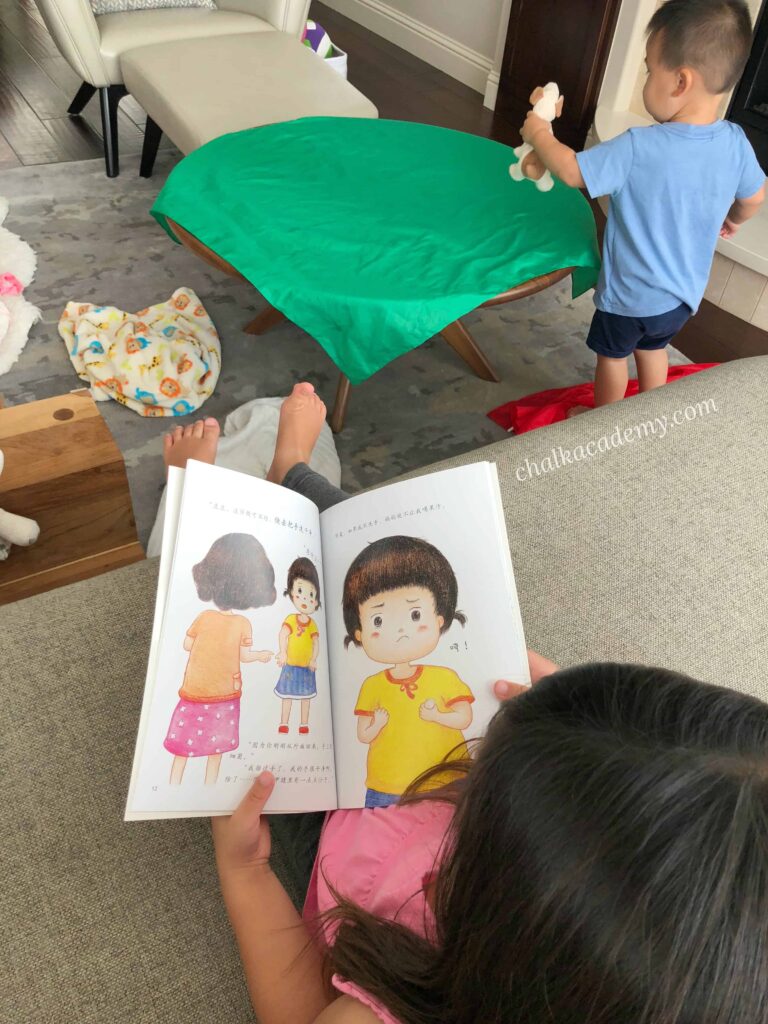
(1) Things to consider before teaching your child to read Chinese
Priorities
- Observation and listening/speaking skills are the absolute priority for learning a language. 看听说读写 (look, listen, speak, read, write) is the natural order.
- Although older children and adults may be able to learn to speak and read Chinese simultaneously, most people, especially young children, need a solid listening/speaking foundation.
- Reading can certainly improve speaking skills (eg, vocabulary), but verbal skills may be a ceiling for reading progress.
- Comprehension and fluency are more important than knowing a specific number of Chinese characters.
Developmental level
- On average, children learn to read around age 5-6, so please do not worry if your toddler cannot read.
- Every child develops at their own pace. We do the best that we can to nurture and know that we can’t rush nature.
- If a toddler happens to be an early reader, this should never come at the expense of playing and normal toddler activities. Life is short, and kids need to have fun!
Circumstances
- Language is best taught by a native Chinese speaker, but non-fluent parents can pass on the language, too.
- People in small, non-diverse towns have limited options.Our wonderful Chinese teacher is available only once a week.
(2) Why I prioritize Chinese reading over English at home
Although my daughter learned the English alphabet/numbers at age 18 months and the Korean alphabet at age 2 years, Chinese was the first language that she learned to read.
The minority language should be front-loaded
I wanted her to have the chance to enjoy reading Chinese before her dominant language, English.
As Dr. Oliver Tu advised, once a child has learned to read the native language, the minority language may quickly seem uninteresting.
Since English is naturally more important in our community, when I show my daughter that I prioritize Chinese, she understands that it’s important.
Learning Chinese characters provides instant gratification
Chinese may be easier for toddlers to learn compared to an alphabet-based language like English and Korean.
Words are like puzzles: Chinese characters and bigrams (2 characters together) are “completed puzzles” that represent a person, place, thing, or concept.
Once committed to memory, recognition of a Chinese character provides instant gratification.
On the other hand, alphabet letters are puzzle pieces.
With the exception of whole-word reading, English and Korean words often require 2 mental steps to read:
- Producing the correct phonetic sound, and
- Blending sounds to form a word.
Opportunity to have a natural study partner
Since I am also learning Chinese, “studying” is much more fun with a cute buddy!
(3) Initial challenges and regrets with Chinese and Korean teaching
Chinese learning challenges
When my daughter was age 2.5, I introduced a few Chinese characters despite being unsure and inconsistent about speaking Chinese.
Around age 3, Chinese speaking and character exposure became routine and we luckily found a Chinese tutor for my daughter.
Although her tutor had never taught a child so young, she was eager to try!
During those first lessons, she quizzed my daughter with many flashcards. Despite some success, my daughter was quickly resenting Chinese lessons and wanted nothing to do with flashcards. The Chinese flashcards had characters and images on opposite sides.
Since my daughter was asked to focus on the Chinese character instead of the image, she was frustrated.
If her teacher asked her to look at the flashcard, she would turn her head away.
After a few months of resistance from my daughter, I kindly asked our Chinese teacher to focus on conversation skills and minimize character review during class.
Korean learning challenges
Around age 3.5, my daughter began to blend Hangul phonics and read Korean. As my daughter’s reading skills improved, her Korean tutor began to read to her less and expected my daughter to read out loud more.
Previously, lessons were fun and filled with music, stickers, and crafts. My daughter was understandably upset that lesson expectations changed, resulting in an unfortunate aversion to Korean learning.
Another challenge was that the teacher felt that she should be reading phonetically when my daughter preferred whole-word reading.
We eventually ended Korean lessons and took an 8 month reading break from Korean.
Although we had a good friendship with the teacher, I regret not asking her to hold off on reading and instead to focus on creating positive associations with the language. I trusted her as the language expert since I know very little about the language.
Reflection
Please note that by sharing this, I don’t mean any disrespect to either teacher. I know that they care very much about teaching, and I am grateful that they have put in their heart and patience for my daughter.
Traditional Asian teaching methods have worked for many kids, or perhaps those kids don’t have a choice. But my daughter lives in the United States where minority languages are elective and often socially discouraged.
Since language involves a reciprocal exchange between two attentive persons, I try not to think of myself as a “teacher/lecturer” and my daughter as a “student.”
Instead, we are on equal ground.
I observe and listen, just as she does with me.
Two things happen when I listen to my daughter:
- I know what she likes and therefore what to teach her.
- She is more likely to be receptive to learning.
Therefore, despite these initial setbacks, I knew my daughter was ready to read.
We just needed to present Chinese characters and Korean letters in ways that inspire natural curiosity.
The rest of the post will focus on Chinese teaching, but the principles can apply to any language.

(4) How I chose the first few hundred Chinese characters to teach
Many people assume that textbooks and flashcards are the only way to teach Chinese characters.
However, I taught my daughter numerous characters before she read them in books, and we have rarely used flashcards.
While daily reading to kids is one the most important keys to building literacy, we had very few Chinese books in the beginning.
I also could not (and still can’t) read well.
Even when I would try to read the few books that we had, my daughter kept asking for English books.
I soon realized my daughter needed exposure to Chinese characters outside of books (eg, in our regular environment), and I’m glad that I taught my daughter characters before starting any reading program.
Knowing over 100 characters before starting Chinese leveled readers meant that my daughter had confidence with the curriculum.
Over the past 2 years, I have continued to teach her several hundred characters outside of formal reading curricula.
I’ll first give a general overview of the first few hundred characters that my daughter learned. Then I will share specific details on how I helped her learn outside and inside of books.
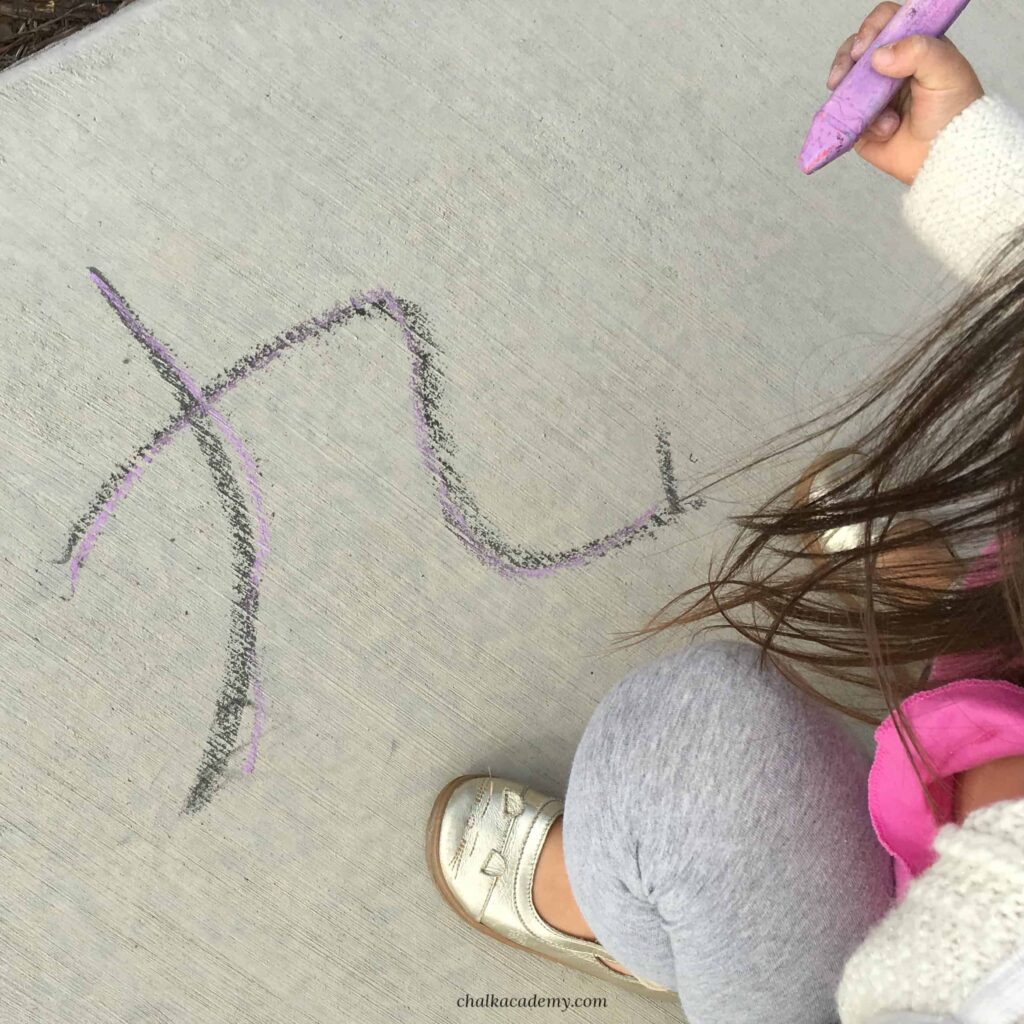
Follow the child
Many parents have asked if I followed a particular list of the high-yield Chinese characters. There are “high yield” word lists floating around the internet, but these lists generally reflect adult vocabulary and not “kid talk”.
Thus, instead of worrying about what other people think are the most important first characters, I initially focused on:
- Words we used in daily conversation
- Concepts that my daughter understood well
- Topics that she was interested in
- Characters in books that she wanted to read
First 100 Chinese characters
Starting around age 2, my daughter was into counting and tracingThus, I often wrote Chinese numbers outside with chalk, and she enjoyed writing over them with different colors.
Since she loved the months of the year song in English, I taught her the Chinese translation. On our easel, I wrote 一月,二月,三月,四月,五月,六月, 七月,八月,九月,十月,十一月,十二月 , 一年有12月.
We would sing it together while pointing out the characters! That time was very easy since she was obsessed with tracing!
Note: I have to contrast this with my son who is currently 27 months old. While he can recognize a handful of Chinese characters, he has totally different skills and interests than his sister. I can’t imagine him doing any tracing in the near future! Therefore, please do not expect your child to trace numbers at age 2 if he lacks interest, focus, comprehension, and fine motor skills for the task!
At that time, I did not take many photos, but I recorded the first ~50 words that my daughter learned.
In addition to Chinese numbers, she had learned the following Chinese characters by age 3,:
大, 小, 我, 有, 我们, 好, 爸爸, 妈妈, 弟弟, 的, 爱, 心, 红色, 土, 口, 耳朵, 太阳, 多, 木, 水, 山, 上, 下, 月, 朋友, 毛, 虫, 手, 中, 个, 人, 鸟, 飞, 美, 石, 老师, 谢谢, 什么, 草, 花, 天, 雨, 星星, 果, 早, 上, 高兴, 是, 看, 女
As you can see, the first Chinese characters were a mix of family members, nature, and common radical characters.
After the above set of Chinese words, the next 50 or so characters were verbs, colors, shapes, food, body parts, and animal names.
Other early words included 的, 想, 要, 没有, 不, 能, 可以, 会, 再见, and 吃.
In reviewing the above list of first Chinese characters, you’ll notice:
- My daughter learned many words as bigrams rather than individual characters. That is because she understood those concepts as the combination of characters. For example, initially, she learned 朋友 together and not 朋 versus 友. And I think that’s okay!!! If your child does not yet understand them as separate characters, you don’t have to divorce 朋 from 友. Trust that the characters will click in the future with more exposure and practice!
- Stroke complexity had no relationship with her ability to remember the character. Instead, success depended on her interest and understanding of the concept.
- I made a point of teaching her how to read complete sentences early on. When she could read “我想吃很多苹果” and “我爱我的弟弟”, her interest level skyrocketed as it was incredibly satisfying compared to reading random words out of context.
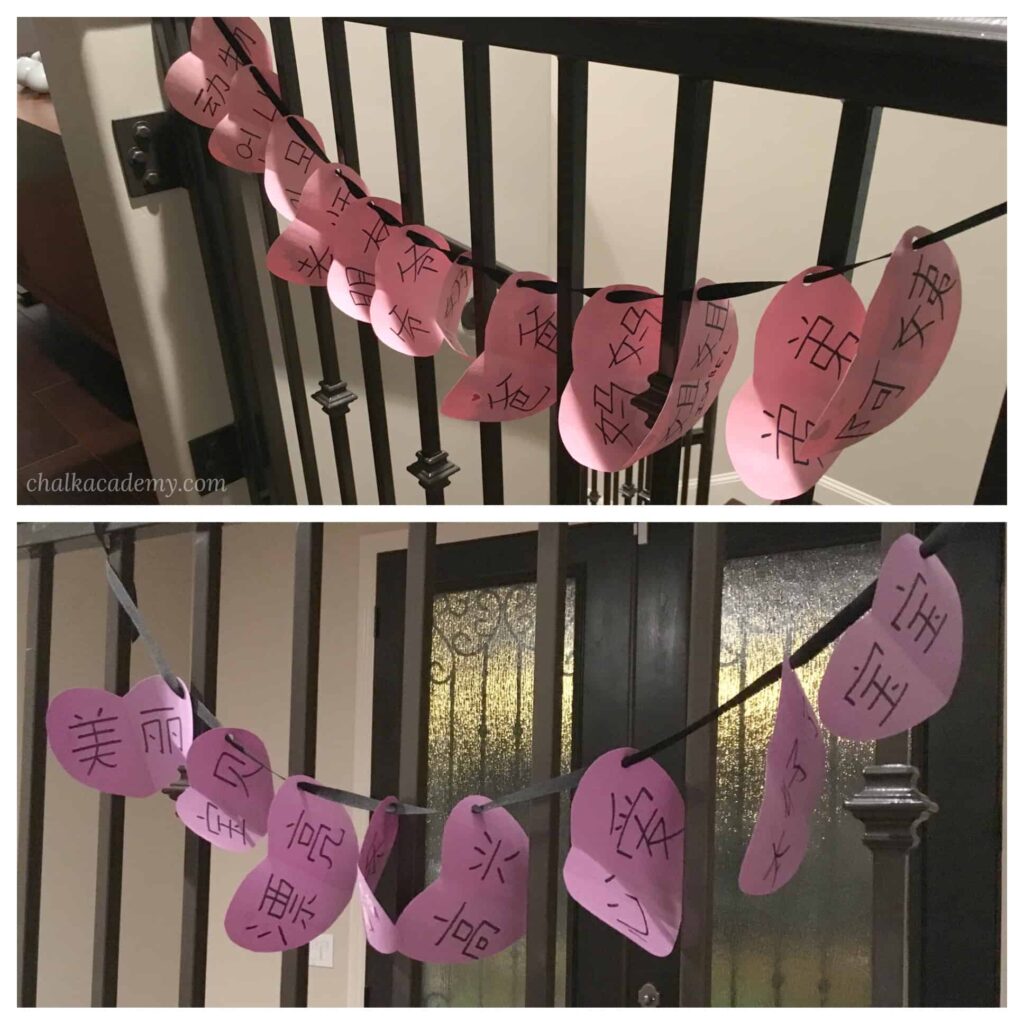
Why I did not teach pictographs
I believe that etymology is important and plan to teach my kids about character origin someday.
However, my humble opinion is that etymology progression requires extra steps to process the transformation from picture to Chinese character.
That time could be spent on just looking at actual modern Chinese characters.
Similarly, although traditional Chinese characters and simplified Chinese characters are related and knowing one script will help the other, you still need frequent exposure to the actual character to know what it is.
Therefore, I simply taught 马 / 馬 (mǎ) as horse associated with a realistic picture of a horse and not all of the written variations that preceded the current Chinese character.
Next few hundred Chinese characters – the importance of radical and phonetic patterns
While learning radical characters like 口, 月, 人, 木 etc, my daughter also memorized more complex characters.
We would point out and name familiar components of each character.
After about 200-300 characters, my daughter was able to have an educated guess of the pronunciation of new characters by:
- Recognizing the character component and
- Identifying the radical (semantic) component
My relaxed approach of teaching her whatever words that interested her really paid off around the time that she hit this milestone.
Familiarity with radical and phonetic patterns allowed for Chinese learning to progress quite quickly after this point.
For example, 请给我 (Qǐng gěi wǒ / Please give me) was one of the first phrases that she learned to read.
Because she knew 请, she could guess 請 (traditional Chinese version of please), 青 (qīng / greenish blue), and 清 (qīng / clear, clean).
After learning several hundred characters, I have periodically done radical-based review to help her remember the characters better out of context as she is now learning to write Chinese.
However, new characters are almost always from real life interest or books that we are reading because it’s best to learn in context, rather than random words.
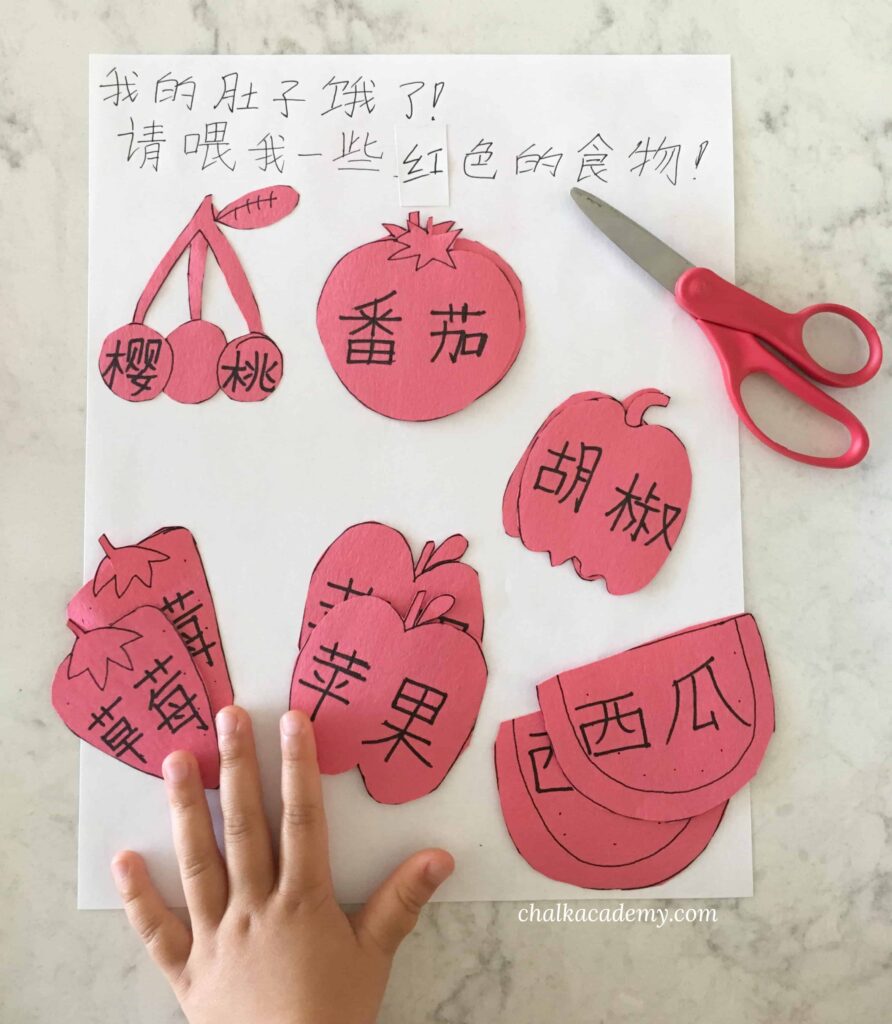
Fast forward to present day
My son
I am not teaching my 27-month-old son Chinese numbers, because unlike my daughter, counting is still an abstract concept to him.
He can rote count but does not understand 1:1 correspondence.
Instead, I have taught him characters like 口, 木, 人, 女, 月, 雨 because he knows what they mean.
For the record, he doesn’t know any Korean or English alphabet letters. He can only recognize numbers 2 and 5 – his age and my daughter’s age – but just calls them “弟弟 birthday” and “姐姐 birthday”!
Every child achieves milestones at his own pace!
My daughter
Although my 5-year-old daughter knows over 1000 Chinese characters now, following her interest is still key.
Recently, I made the mistake of trying to encourage her to try a 木 radical activity that I had prepared.
Instead, she had asked me to print out lyrics to her favorite praise music so that she could practice reading and writing the characters, but I put it off because I had already planned the other activity.
Big mistake on my part – she was so unfocused during the lesson.
Then, I printed out the requested song lyrics, and she was so motivated to read the characters along with the music!
On her own accord, she wrote several Chinese characters from the song by memory on a steamy glass door during a shower.
I can’t stress this enough that the first step is to follow the child, and I need to remind myself that from time to time!
(5) How I get my kids to notice and remember Chinese characters outside of books
1. Make BIG, noticeable signs with Chinese characters
Have you noticed that kids are curious about big red stop signs, yellow danger signs, and no smoking signs?
STOP was one of the first English words that my daughter could read, simply because she has seen it at every street corner since she was born.
Signs catch attention with the simple but bold design.
At home, especially in an English-dominant environment, I have to make Chinese words catch my children’s attention.
Here is 手 (shǒu / hand) with a drawing of hands on our easel.
Tips for creating Chinese signs at home:
- Make sure the character stands out
- Since I wanted my daughter to learn 手, I did not write “shǒu” or “hand”. I see many commercial Chinese learning products with Pinyin/English next to the Chinese character, and I am concerned that these are often distractions from the goal of character retention.
- If absolutely necessary for your personal reference, Pinyin/English should be small and discrete compared to the Chinese character. My recommendation is for Pinyin to be not visible to the child and to include English or another language only if the child is also learning to read it. Otherwise, the visual priority should be on the Chinese character.
- Limit color use
- More colors = more information to process. I love the concept of black & white flashcards because they are visually clean, but I think a pop of color is also effective for capturing attention.
- An explosion of color will obviously stand out but may be counterproductive to seeing the Chinese character for what it is.
- Put up a few signs – key words that you’d like to teach you child. Some people label the whole house, but for us, that can be too many characters. Know that if you don’t change up the way characters are presented (eg, rotate the signs), the mind may begin to ignore it if it’s not interesting or new.
- Put signs next to the real object if possible. Other than a few printables, I rarely use clipart because I don’t have time to look for images, and real-life examples are free and often more effective for creating associations. This is because real objects are tangible, and kids are absorbing the information through multiple senses.
For more tips, please read Create a Print-Rich Environment with Labels that Promote Literacy.
When your child has become more advanced, you can add more information to those signs as shown below!
To critique my own easel messages, I think the text is too colorful, and I wish I used a dark marker for all of the characters.
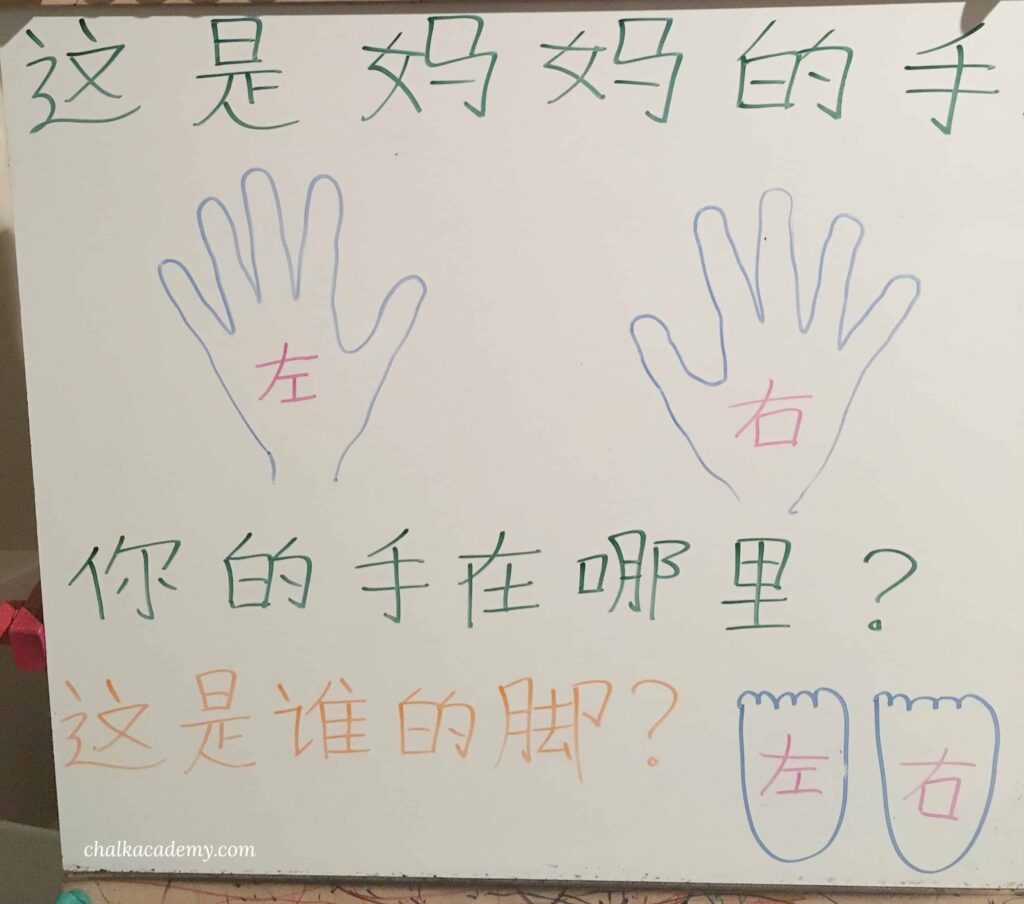
2. Limited choices strategy in teaching Chinese characters
Offering limited choices is one of my general parenting strategies, for example:
- “Will you put your toys away in 2 minutes or 5 minutes?”
- “Which do you want to do first: shower and then brush your teeth OR brush your teeth and then shower?”
- “Do you think that activity is safe or dangerous?”
- “Should we touch the electrical outlet – yes or no?”
- “Is it a good idea if mommy puts the books back neatly on the bookshelf?”
This approach to communication has resulted in generally obedient kids and a relatively clean, safe home (knock on wood) in addition to increasing verbal skills and confidence.
Choices are provided when they are reasonable, and yes or no questions are asked when the situation is black and white.
My kids are also then encouraged to reply back using specific language that I have suggested.
In the next example, you can see how I have applied this principal to reading practice. 错 (cuò / wrong) was a new word for my daughter, and I paired it with 对 (duì / correct).
The goal of this activity was to read each sentence and determine whether it was 对 or 错!
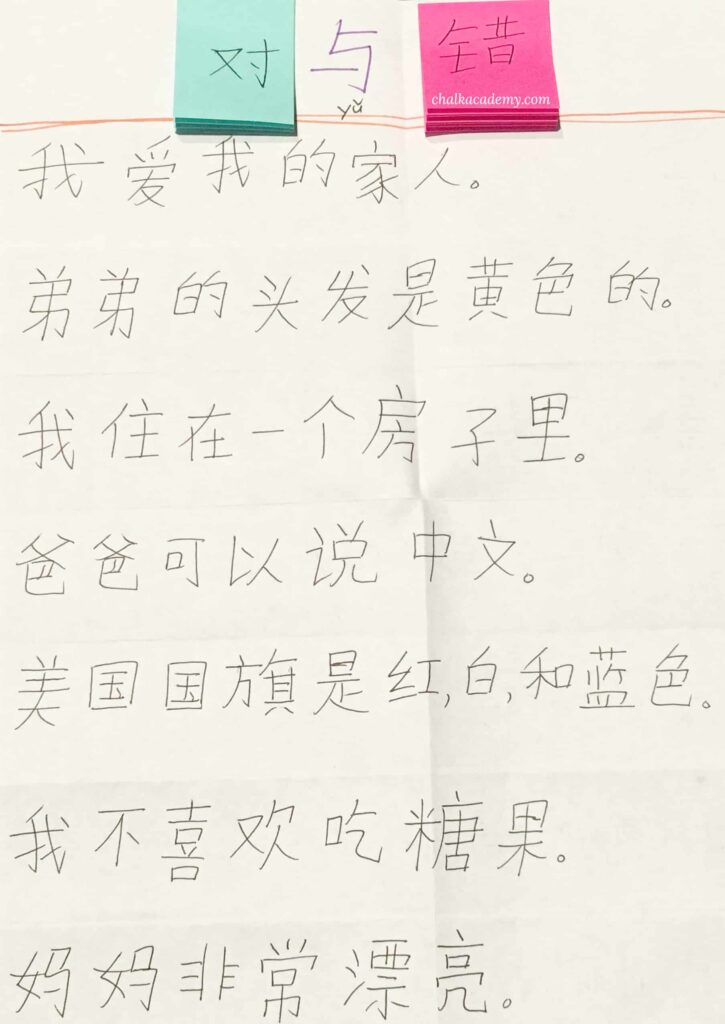
Before my daughter could read all of this, I would write 2 opposite words on a piece of scrap paper or Post-It note and ask her to indicate which word she agreed with.
For example, I would present 喜欢 (xǐhuān) with 不喜欢 (bù xǐhuān) or 想要 (xiǎng yào) with 不想要 (bùxiǎng yào).
She would either point to the character or say the answer if she remembered how to pronounce the word.
This approach is similar to that of the Montessori 3-period lesson.
3. Personalize Chinese characters
Since kids love stories about themselves, my DIY reading exercises typically pertain to our regular life!
My daughter thought the true versus false game (photo above) was super funny!
Here is another example of a reading exercise that I created to discuss her bedtime routine and practice telling time.
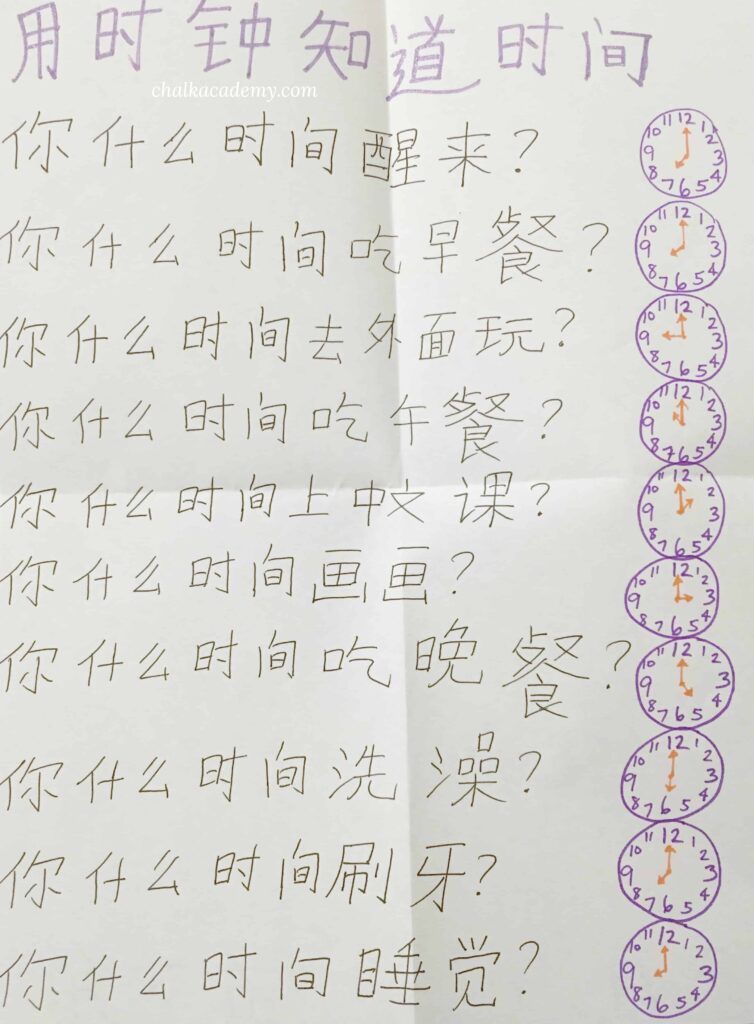
Note: Please remember that I am not fluent in Chinese, so there may be grammatical errors in my DIY examples! Kindly alert me of any errors so that we can improve our Chinese skills together!
I also wrote down food that she was eating, farmer’s market shopping lists, pretend play signs, bedtime routine, and other things from our daily life.
Although this type of writing would occur naturally to native-speaking Chinese people in Asia, these basic opportunities can be easily overlooked when Chinese is not your native language.
4. Teach Chinese characters with repetition, repetition, and more repetition
Chinese learning requires constant exposure for retention.
To help my daughter remember new words and phrases, I would write up a page of sentences or questions with a focus on certain words or letters.
This next example is focused on “什么时候 (shénme shíhòu / when)” and “可以 / (kěyǐ / can).
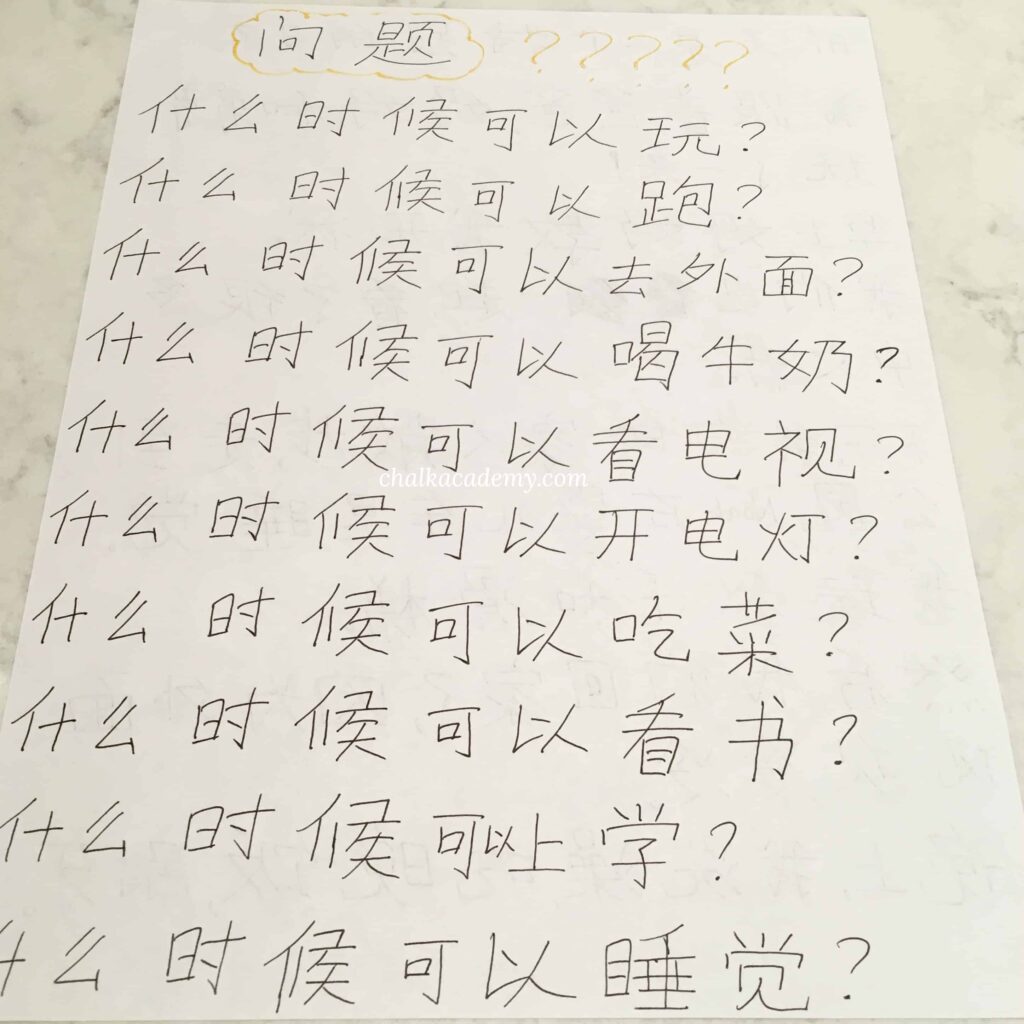
Here I have highlighted 房间 (fángjiān / room) as the focus words for my daughter:
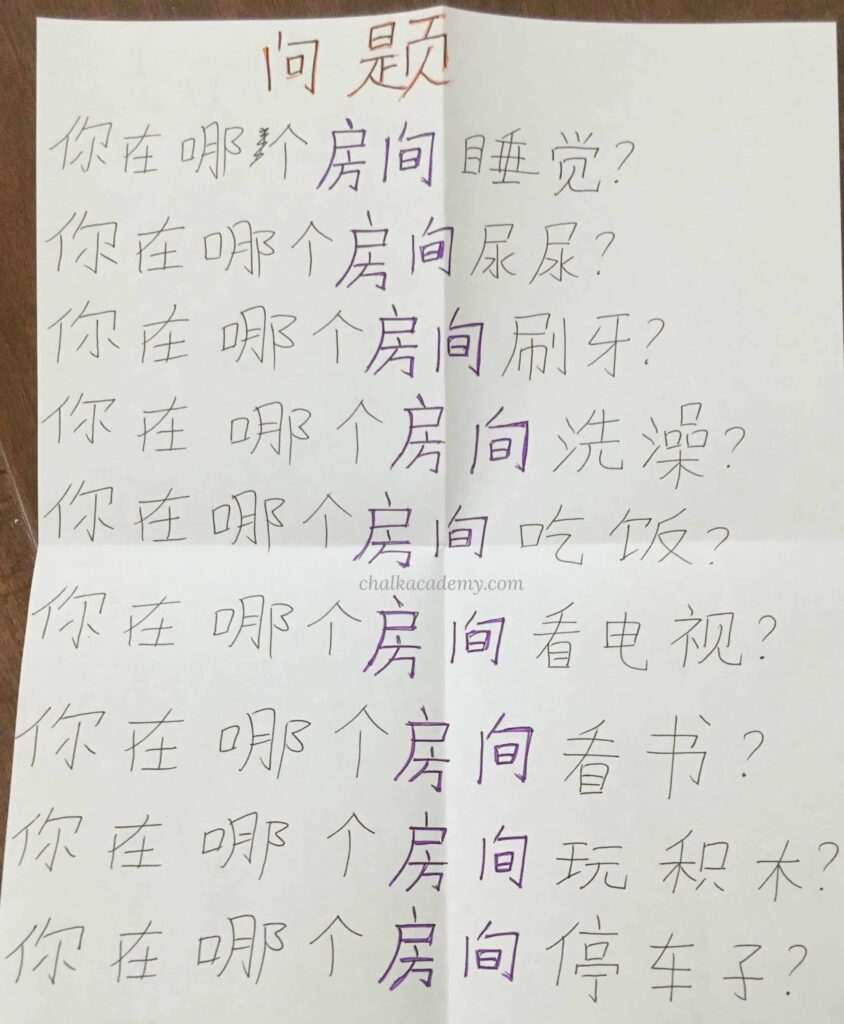
I stored these random reading exercises in a 3-ring binder so that my daughter could look back on things that we read together.
I saved this binder, and my daughter has fun looking back on our very first activities!
5. Write Chinese characters (and let your child fix it!)
As you can see in all of the previous examples, I generally write everything for my kids.
Since I am trying to improve my own Chinese, writing helps me remember the characters.
Although Chinese printables are convenient and I enjoy making and sharing them, the slow process of writing lets children see how a Chinese character is created.
Through writing, my kids get to see how Chinese characters are formed with pencils, pens, markers, paint, chalk, etc.
Even when my kids ask me to draw a picture, I first write down the Chinese character and then draw the picture.
I handwrite the labels around our house.
Thank goodness for Chinese dictionary apps which provide stroke order animation and definitions!
The downside of handwriting is the risk of error.
Accidentally, we discovered that this was a great way for my daughter to practice visual discrimination of different characters.
In the example below, I forgot to write the 4 dots at the bottom of 熊. My daughter realized that I wrote 能 and fixed my mistake!
This “find the missing stroke activity” has been very effective and fun for my daughter!
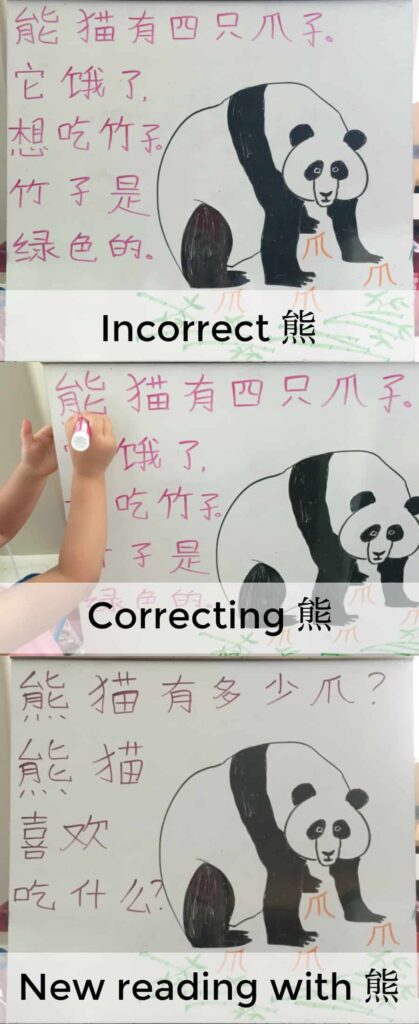
6. Experience the Chinese characters with all senses
Since a huge part of this website is dedicated to hands-on Chinese activities,
I will briefly summarize active learning strategies (as opposed to simply looking at the Chinese character):
- Touch:
- Chinese character puzzles allow kids to feel the whole character in their hands.
- Children age 3+ who can follow directions may benefit from sandpaper letters and tracing boards which give tactile input while tracing Chinese characters. However, we DIY’d some of our own tactile words with puffy paint and didn’t have these professional materials initially.
- Build:
- Use playdough, Legos, twigs, stones, pipe cleaners, or any object to create Chinese characters! The prerequisite to this is that your child should be able to trace objects on a line.
- Older kids may enjoy putting together puzzle pieces of Chinese words.
- Match:
- In the beginning, instead of asking my children to name Chinese characters, I ask them to tell me which are the same and which are different. This takes the pressure off memorizing the characters and instead lets a child take their time with comparing and contrasting characters. You can see my daughter using this strategy with her brother in the below video.
(6) How I taught my daughter Chinese characters with books I could not read
1. Which Chinese books to buy?
In the beginning, I had a hard time finding Chinese children’s books that suited my family.
Once I found stories that my kids could connect to (eg, well-illustrated stories with relatable everyday topics and humor), they fell in love with Chinese story time.
Books helped us build vocabulary and improve grammar.
A variety of Chinese books at home is necessary so that your child has Chinese options readily available.
My suggestion is to first buy Chinese picture books and put Chinese words from your child’s favorite books in activities, games, or labels around the house.
After learning common and relevant Chinese characters as I have discussed above, then I think it’s a good time to introduce leveled readers.
Chinese leveled readers are designated specifically to teach at least a few hundred of common Chinese characters, but the content and illustrations are often not as interesting as regular picture books.
However, if your child is interested, you can always try to introduce them to see if they like them. We used the following books in the following order:
- Sagebooks: The Books That Taught My Child How To Read Chinese at Age 3
- Greenfield: The Chinese Books That Gave My Child Reading Confidence
- 四五快读 Review & How We Used Si Wu Kuai Du as Non-Native Chinese Speakers
- Odonata Chinese Readers (1200 Simplified Chinese Characters) – Book Review
Click on the links above to learn more about what each series entails and how we used them.
Note: There is a new Chinese leveled reader series, 樂樂文化 聽讀套書 Le Le Chinese 300 Books, that covers 1000 Chinese Characters in either traditional or simplified Chinese. The series comes with a reading pen which is helpful for non-fluent families like myself. We used the series after this article was published.
2. Connect pictures and Chinese characters
When my children read picture books, I always let them take their time to study the pictures.
Pictures are naturally attractive and fun for kids to explore. Sometimes they take a “picture walk” quietly by themselves, flipping through the illustrations.
Children need time to satisfy their visual curiosity; this is precious time for observation and independent analysis.
In addition, discussion of illustrations is a prime opportunity for Chinese speaking practice.
My daughter has now developed the healthy habit of analyzing the illustrations before, during, and after reading.
When she first learned to read, she would ask if her assessment of the picture was true.
In response, I explained that we all can have different interpretations about an image, but we can check the words to see what the author was thinking.
This motivated her to be curious about the Chinese characters.
As I read out loud, I often use my finger to point out pictures and then words related to the picture.
I also point to words while I’m reading, sometimes tapping my finger on the Chinese character for emphasis.
But again, if my kids are taking their time with the illustrations, I try not to interrupt their focus.
Diverting attention from illustrations to text is one of the most frustrating things that my daughter has experienced from formal tutoring as mentioned above.
Instead, when the child is ready to turn to the next page, that could be a golden opportunity to point out a Chinese character.
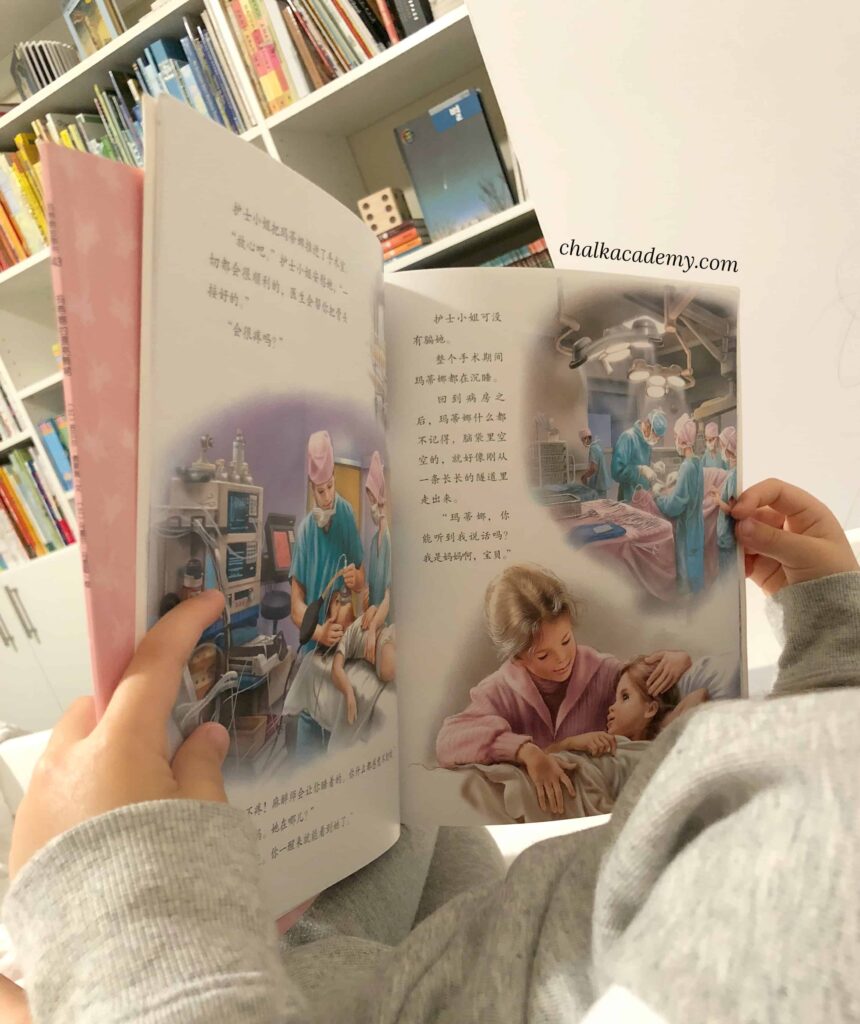
3. Dramatic reading
I try to be a bit dynamic with my reading to make the story come alive.
Honestly, I am a terrible actor and can’t make any funny voices, but I try to be expressive and active for the sake of my kids!
If you need inspiration for how to read in an engaging way, I recommend watching YouTube videos of Chinese storytellers and emulating their energy for your kids!
Acting is also an extremely effective strategy for committing new characters to memory and testing reading comprehension.
For example, when we encountered “青蛙跳来跳去 (qīngwā tiào lái tiào qù / the frog is hopping) in a book, we would hop on the ground.
For reading comprehension, my daughter and I will sometimes act out what we think is happening.
During imaginative play with little brother, my daughter will often use characters from books that she has read!
Here is an example of her acting out 狼和七只小山羊 (Láng hé qī zhǐ xiǎo shānyáng / Wolf and the Seven Little Goats) at age 4 years.
4. Teach Chinese characters: Fill-in-the-blank collaborative reading strategy
These days, my daughter and I will typically take turns reading alternate pages or chapters.
However a couple years ago, when we’re about to approach a word that my daughter has memorized, I would take a moment to pause as an invitation for my child to chime in and fill-in-the-blank.
Ironically, as my daughter’s Chinese reading has long outpaced mine, I am usually pausing for her to help me!
Another game that we have played is “I Spy” where you look for familiar characters and things in the pictures.
But don’t worry if your child doesn’t want to participate. Even if he or she is an early reader, keep reading out loud if your kids have not outgrown it.
Kids learn from our modeling, and reading is important for parent-child bonding.
Although my daughter can read better than me, she still wants me to read to her all the time! I often take the role of the humble student while she gets to be my teacher.
5. Highlight key Chinese characters with Post-It notes
At the start of this post, I mentioned that I rarely use flashcards with my kids.
While they are a popular resource for many families, I am overwhelmed by the idea of sorting, organizing, and finding the right Chinese character.
For our family, Post-It notes are a very useful for highlighting Chinese characters.
In the beginning, I wrote Pinyin and English below the Chinese character for my reference. Later, I realized that the extra text can be distracting my daughter.
Whenever necessary, I now write Pinyin and/or English on the back of the Post-It so my daughter can focus on the Chinese character as shown in the 林明子 book below.
Later, I can take the Post-It notes out of the book for us to review together and play learning games if needed for reinforcement (eg, Chinese tic-tac-toe).
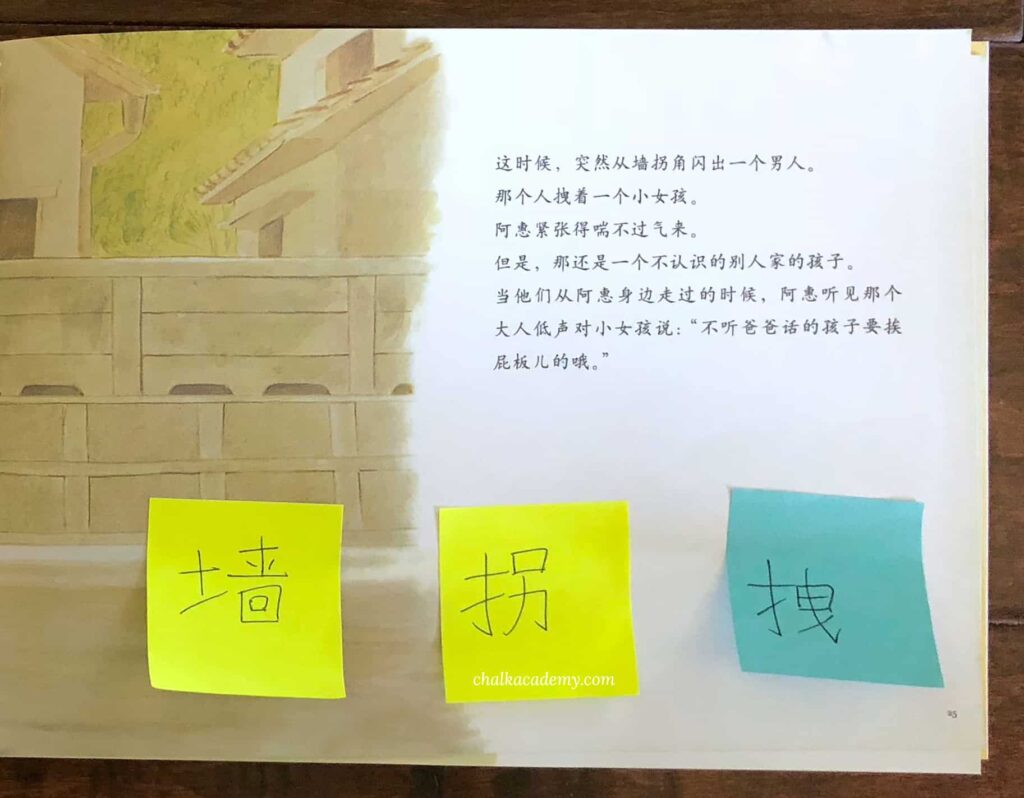
I also occasionally use Post-It notes to create Chinese word walls for my kids.
I mix in familiar characters with new ones so that they are confident about knowing at least some.
Now that my 2-year-old has learned some characters, I have included a few easy characters for home at his eye level.
The bright pink paper in the photo below gives me a headache, and I wish we had white or pastel Post-Its! But I have a jumbo pack of these that I need to use up!

Here’s another example of a Post-It note word wall.
Notice how the white paper is much more soothing on the eyes, and the Chinese characters stand out even more!
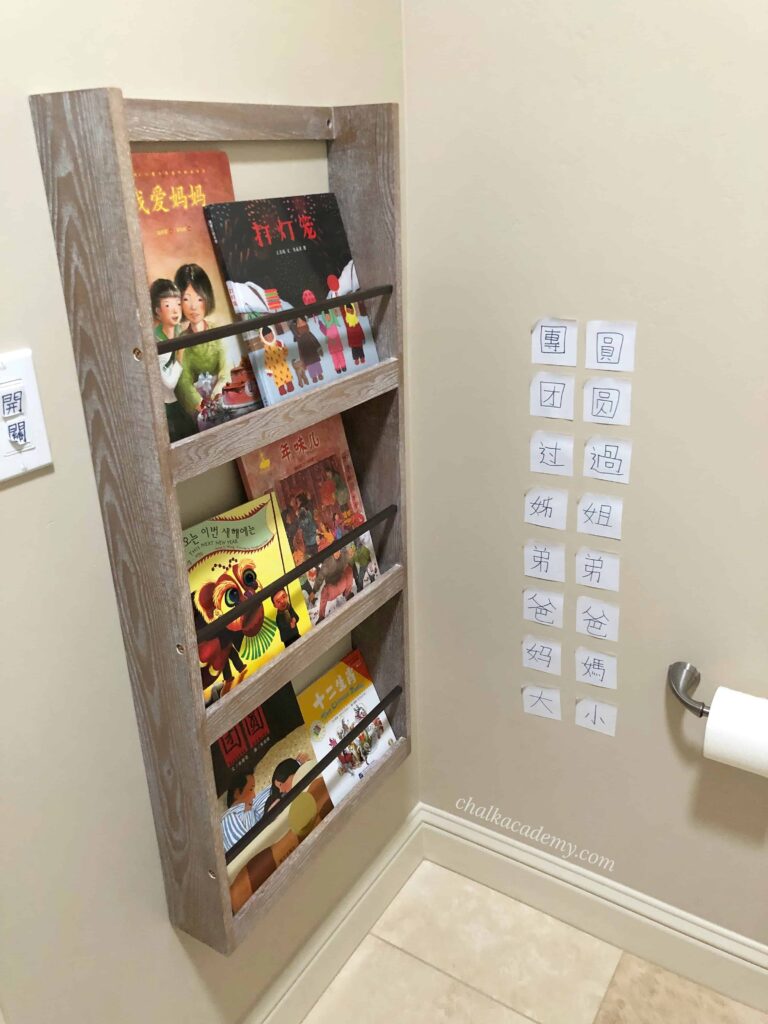
Despite my lack of fluency and literacy, rather than hunting for a flashcard, I find that it’s much easier to copy a character onto a Post-It note and then recycle it when we are done using it.
This is just my humble opinion which I know is in the minority since flashcards are very popular among my internet friends who are learning Chinese! 🙂
6. Stickers to track Chinese characters for review
Chinese sticker activities have been a low-prep and effective learning tool.
With reading, we sometimes use red and green removable dot stickers to indicate unfamiliar and learned characters, respectfully.
In the photo of 四五快读 below, a red sticker is placed beside 顺 (shùn / along, follow, obey) because she didn’t know the character and then later replace with a green sticker.
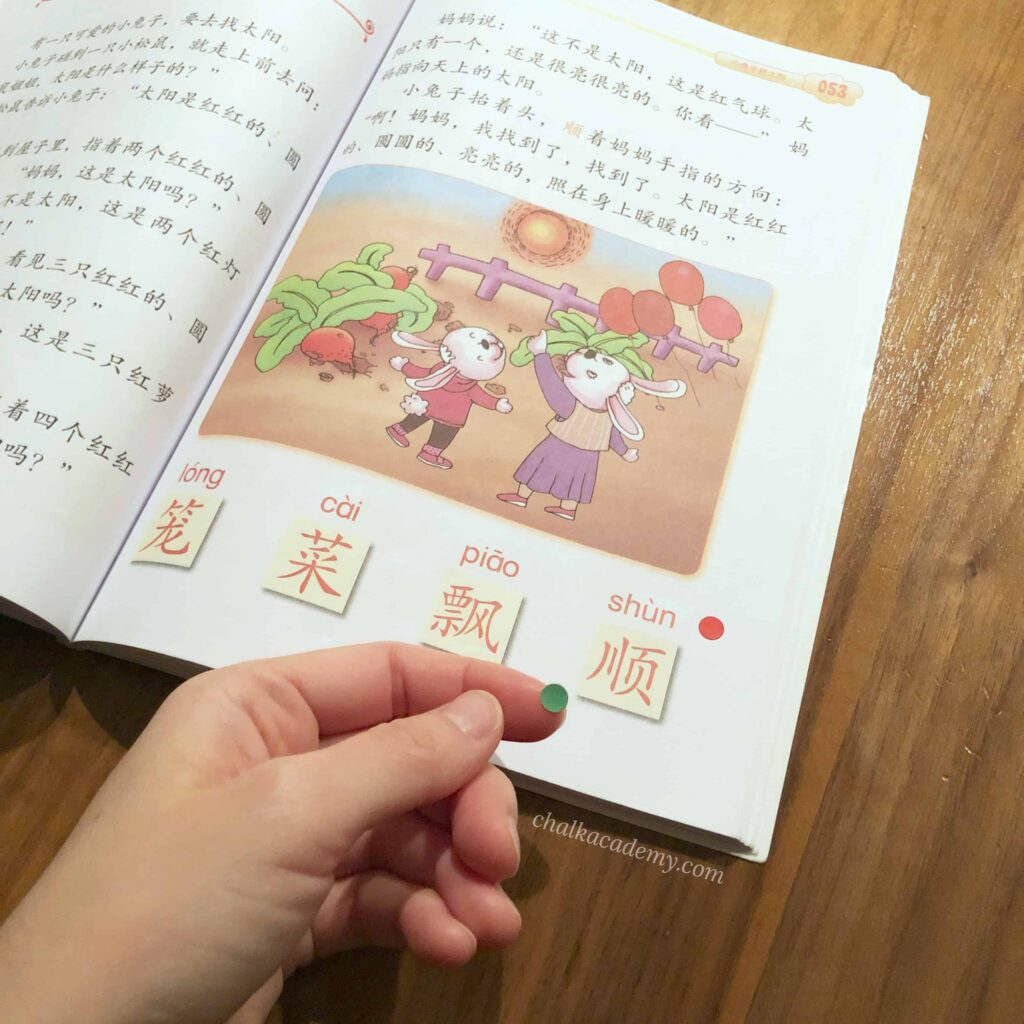
Now that my daughter is reading more fluently, I want to encourage her to enjoy reading independently without worrying about asking me to help her look up unfamiliar words.

When she encounters a new or forgotten character, she will skip it and make a mental note to come back to it or mark the spot with a Post-It strip or dot sticker.
Later, I will write the character on a large Post-It note for review.
7. Teach Chinese characters: Context, context, context
Every month or so, I try to come up with a theme that is seasonal or related to something my kids have shown interest in.
In order for my kids to see the topic presented in different ways, I select a few books and structured activities related to that topic.
This allows for repetition of common vocabulary related to the topic.
In the photo below, you can see that we have a bookcase with nature-related books and learning activities that reinforce nature words in Chinese.
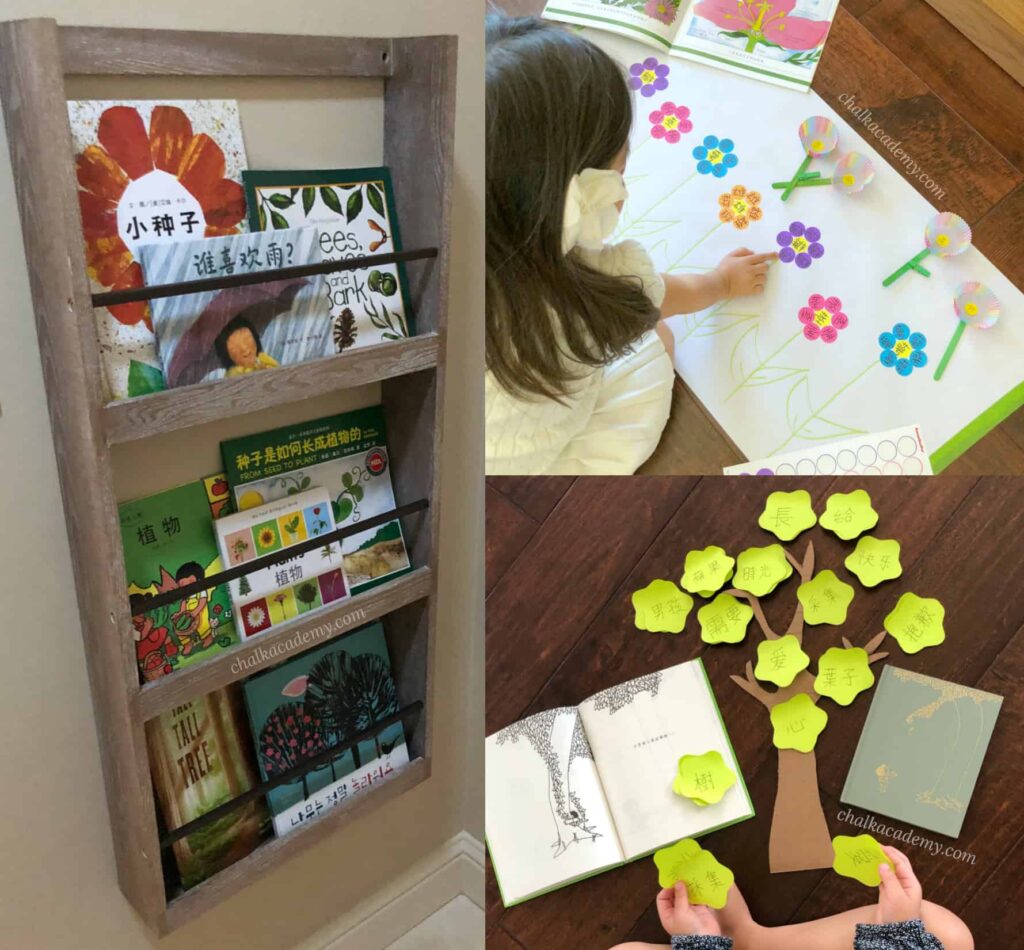
Our topic time frame is pretty flexible though, as we did nature-related activities for a few months, but spent only 1 week on geography last year!
Check out our Learning Topic Library Menu and how we have implemented themes into our trilingual schedule.
8. The power of audiobooks
As my daughter’s Chinese skills outpaced mine, audiobooks have helped her continue to grow.
Honestly, since my daughter began to read independently, I have gotten a bit lazy about keeping up with pre-reading and my own online tutoring.
I have to credit Chinese audiobooks on Ximalaya for doing more advanced teaching!
Also, with a rambunctious 2-year-old son, it can be hard to sit down and read with my daughter. We have to be flexible with 2 kids at different stages of life.
On her own, my daughter can listen to new and old audio stories over and over again.
After a few listens, she memorizes the story, and it helps her identify unknown Chinese characters in the book.
Try this: How Kids And Parents Can Learn Chinese From Audiobooks
(7) What if she forgets or has trouble remembering a Chinese character?
Character loss happens all the time, which is why daily reading and creating an immersive environment are necessary.
When my daughter forgets a Chinese character, I don’t show much of a reaction.
My daughter knows that I forget characters all the time, way more often than her.
I simply write down the forgotten word on a Post-It note, and she will look at it for a few minutes when she is sitting down, such as in the bathroom, while eating, or in the car.
If she still can’t remember it, it’s usually because we don’t use that character in our regular conversation. We just move on, knowing that there will be future chances to learn that Chinese character.
The concept might also be abstract for her, resulting in her mind not prioritizing the information.
This is why listening and speaking skills are so important!
(8) Maintenance mode and next steps for teaching Chinese characters
For a while, we have been in a plateau phase for Chinese learning. We have had a very busy past few months and have not been able to read as much as we should.
In addition, our speaking progress has been somewhat stagnant, and I really need to get back into my own online Chinese tutoring sessions this new year.
As mentioned previously, speaking skills can limit reading progress.
I would like to teach her Pinyin and Zhuyin soon so that she can be even more independent.
However, she really despises phonics even though she has known Korean and English phonics for a while!
Although she has self-taught some English and traditional Chinese characters, I wondered if she figured out Pinyin on her own but she guesses wrong half of the time.
Since she likes to memorize Chinese characters, I’m in no rush to push her on phonetics for now.
Thus I am just focused on maintaining her level through interesting books and activities.
Here is my daughter reading a book from 玛蒂娜故事书系列 (I Love Martine Series).
(9) Final thoughts about teaching Chinese
In summary, language should be about communicating and connecting.
Since we live in the United States, we are lucky that we don’t have to worry about Chinese exams or homework.
Chinese is not “necessary” for daily functioning, so creating a positive experience with the language is absolutely necessary.
Find something that you and your child love to do, be it reading, art, music, or sports, and try to be consistent about doing it together in Chinese.
Don’t feel bad if you need to take a break as we have for Korean, and be open to adjusting your strategy should the need arise.
Pray when you feel overwhelmed, celebrate your wins, and never hesitate to ask God for help!
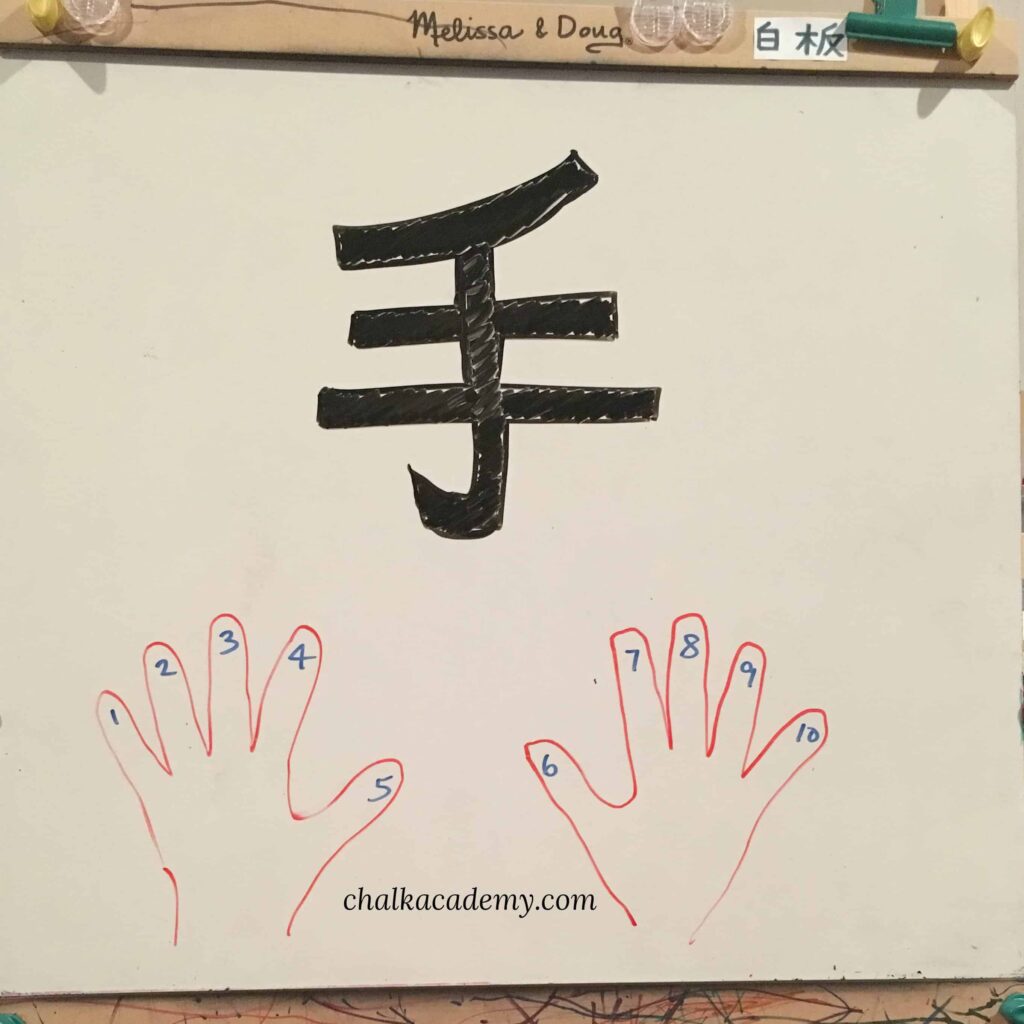
Hi Betty!
It’s so good to have stumbled upon your article.
I am a Malaysian Chinese mom who can speak Mandarin but not good at reading or writing. I am sending my kids to Chinese school. And your comprehensive article is so helpful. I am finding a way to teach my kids Mandarin and I have failed to do a good job with the first two. My youngest will be attending a Chinese school in two years’ time and I hope I can help him build a stronger foundation before he enters school.
Thanks for sharing!
Hello,
Thank you for sharing your experience. Obviously, this has been a great experience for you and your daughter, which is terrific. It seems to be working well for you and that is very inspiring.
I will start in mostly that same way with my kids because generally I have always thought that this is the best way to teach one’s kids things. I always believed that learning doesn’t have to be so miserable (plenty of people learn to become the best in their field through true joy of learning about that subject or learning to do whatever that thing is). Of course, sometimes kids and grownups have to learn things they don’t really like, but it still doesn’t have to be miserable I think. Also, if you aspire to be at a certain level or an “expert”, then some hard work is required, but it can still be positive and a loving experience. I don’t pretend to have all the answers, that’s just my take at present moment, certainly I have a lot to learn about teaching my kids things….
Best Regards,
Eric
-Eric
Wow, very interesting to read. I’m an adult learning Chinese and I probably spend more time reading about the meta-theory of Chinese learning than actually using chinese. Question: Your kid said 妈妈非常漂亮(当然) but also 爸爸会说中文。 Does he?
Kids are really incredible learners, even without such dedicated teaching, though some of us are a bit like your son who hates tracing (I carried that with me for a good 20 years). You might be grateful to find that we live in an age of computers where he can get away with it once he needs to write!
Hi Betty,
Thank you so much for sharing your journey in depth. I’m feeling overwhelmed and I don’t know where to begin. I can’t speak really Chinese (Mandarin) but I can speak a little cantonese. I have a 3 year old (just turned), and he only responds in English. I can’t read or write either. Could you please recommend/suggest what I could do to start?
Hi Amanda! Thank you for taking the time to write! Since are you are more fluent in Cantonese, I would consider focusing on that, take it one day at a time! 🙂 This is my detailed guide on transitioning to the minority language. Music is also a fun way to encourage the new language – you can try introducing one song a week, and for that age, this list of Mandarin children’s songs is a great place to start. Cantonese for Families is a website with lots of resources for parenting, including this list of nursery rhymes.
Thank you.
I don’t have kid, My mother language is not Chinese neither English. I have always been interested in raising children. (My mother and grandmother raising was painful, and I didn’t want to raise my future child like this.) Nowadays I started to learn Chinese, but I needed to put away… Now I’m very inspired.
Srry my grammar is not so good, (my passive skill like reading is better, ’cause I read every day in English)
Again… THANK YOU!
F/young adult
Thank you for sharing this! I can very much relate with your journey. I am a third generation Chinese-Filipino, living in the Philippines, and it was a struggle to learn Chinese when I was growing up. I finally realized its importance now that I have kids of my own. What you shared inspired me to be more vigilant and intentional in teaching characters!
Thank you so much for your kind words and sharing about your family! I hope the ideas here can help your family on your Chinese learning journey!
Thank you so much for detailing this! Needless to say, i’m really impressed with your determination and your daughter’s ability! I live in CA too, though i can read chinese, i still find it incredibly difficult to teach my daughter chinese. she’s 2.5 years old now and definitely prefer english. But this is inspiring and i will persevere! thank you so much for this great resource!
HI Betty! I received my orders from Odonata today! I am so happy these arrived neatly and not wet from our unpredictable weather here in Melbourne. I would like to ask from where you had the above Chinese character map printed off? Is this vista print? I found this but I am not used to this font- https://www.learnchineseez.com/read-write/traditional/index.php?page=1. I prefer the handwritten-like font I saw in the first picture with your Lao-Da here, where she stick stickers on some characters. Can I please ask to have a copy of this from you?
Hi Rose! I’m so glad you got your Odonata books! I just started re-reading them with my son! As for the poster, I received it from mandarinposter.com. To be honest, I’m not sure that I recommend it. My daughter did like going through the poster like a word search game. However, I decided to abandon it because many words were not high frequency for kids (it was made for adult learners). I also felt that going through it took away time from reading fun books, and it also arrived wrinkled. That being said, I think it’s popular with other families which is why I looked into it initially! Hope that helps with your decision!
Thank you so much for your reply! I am fluent in Chinese. But I will definitely try LELE books together with Odonata just to have more options. Thanks again!
Hi Betty! Thank you for sharing all this information! It is super useful! I’ve been following you on Instagram for a while and saving your posts for the future. I would like to ask your opinion about reading LELE books or Odonata books to 1.4y.o. I am Russian and I started to teach my son Chinese and English when he was around 8 months old. I speak with him 3 languages every day 30% of time each language and take online Chinese and English courses for babies to organize our study plan. We also read picture books, play with reading pen (he points to the pictures he likes). I have ordered Odonata books and thinking to order LELE books with reading pen as well. Do you think it is time to start reading those books or it is early? I am so afraid of baby questions time, because I am not native speaker and it will be difficult to find words to explain everything in Chinese or English. It’s easier with English though, there are tons of books and English speaking population. Chinese is different. So when I found your post about LELE books, I thought maybe they could be of a good help to me. I really want him to continue learning and be better than me at this))
Hi Anna! Thank you for taking the time to read and share your story! That’s so wonderful that you’re exposing him to 3 languages!
I think it depends on your proficiency with Chinese. Are you comfortable with reading the Odonata Chinese books? I’ve heard many positive reviews from families who use it as the only leveled readers their kids use because the stories are interesting to their kids!
Thinking about where I was a few years ago when I couldn’t speak Chinese, I would have thought Odonata was too hard and LeLe would have been perfect for us. if you’re not fluent, the LeLe Chinese reading pen system is very helpful because of the reading pen and the wide variety of topics, plus the website has English translations, and you can download free flashcards from my website.
If you have the budget and space, it doesn’t hurt to have more options to see what works best! Look forward to seeing how your multilingual journey evolves!
This is really inspiring, Betty, thank you for sharing. I’m wondering how much time you spend doing all this with your children? As someone who has to work, I’m not sure how much I can do ….
Hi Olivia! Thank you for taking the time to read my blog! I work part-time and I know it’s time is always a challenge especially for those who work full-time away from kids. It always seems like a lot when compiled in one article, but even a few minutes in the morning, before bed, and random parts of the day (pointing out words on the cover of books, sticker word-matching at restaurant or waiting room, etc), can make a big difference. Do the best that you can little by little!
Oh. My. Gosh. Thank you SO MUCH for posting this. I haven’t even read through the entire post yet – and I don’t have kids yet either! But I have already frequently panic about how my future child might be doomed to learning Chinese the hard way which is such a shame because I am only 1st gen (2nd gen?) in America. One of my biggest regrets in life is not being able to speak Chinese and connect deeper with the rich heritage of being Chinese TT_TT and my kids will be even further removed just because of so much I took for granted, whether that’s the food my grandparents or mom cooked, to the places we dined, etc…. it’s history lost if we don’t preserve it!
It’s still on my bucket list to be able to function with normal daily activities using Chinese someday.
Hi Alexandra! Thank you for taking the time to read and share your story! I think the next generation can have a better experience learning Chinese language and culture despite our own challenges! I’m having much more fun learning Chinese this time around compared to when I was a kid, and I hope the ideas here can help you, too!
I am so happy I’ve found your blog! It really helps me to get to know what a non-Chinese speaker feel and how you learn. I do feel inspired. Very impressive to what you have done to your children and yourself. I do not know how you balance your time with so many different roles!
Thank you so much for taking the time to write! I hope that the website can be helpful for your family!
Thank you so much for this blog, Betty!! The blog covers so many aspects. It kinda serves as a manual of how to teach Mandarin at home. After reading it, there are lots of take-away. So I book-marked it my internet browser. I’m sure I will re-read it many times in the future.
I really appreciate the nice message! It’s encouraging to hear that the information is helpful, and I look forward to sharing more together in the future!
It is amazing what you have done. So much dedication on your part as well as your daughter to learn the language. We’re in a similar situation where English is our dominant day to day language and teaching Chinese can be challenging especially because it is not my first language. Thanks for all the tips and tools!
Thank you so much for sharing your story, Maria! It’s so challenging, and we have to pick and choose our battles. I hope that these resources can helpful for your family! 🙂
Your commitment and determination to teach both yourself and your girl are evident in this journey… By now, you already know how you have been an inspiration to countless. Thank you for taking that courage to start this blog, and it is amazing how God has used this step of faith to bless others. Praying you will find a balance and purpose in His plans as you press on in 2019!! Blessed New Year to your wonderful family! I am now refocusing back on my no.1 in Chinese!😄
Thank you so much for Angie! You have been such an inspiration to me, thank you for your prayers and sharing your faith and language journey. Many blessings to your family, and Happy New Year!